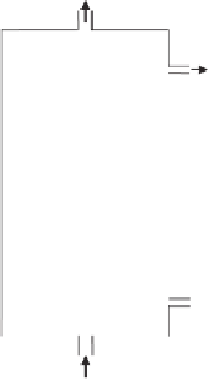Biomedical Engineering Reference
In-Depth Information
Lumen flow out
Shell flow out
Shell flow in
Lumen flow in
Figure 7.7
Hollow fiber membrane reactor.
the size of the cells. Ultrafiltration membranes typically have pore sizes of 20-1000Å.
These membranes can retain macromolecules with molecular weights between 10
3
and 10
6
daltons. Nanofiltration and reverse osmosis membranes, which have lower pore sizes, can
be used to retain smaller molecules.
Membrane bioreactors have applications in fermentation, pharmaceutical production,
protein extraction and wastewater treatment (Inloes
et al
., 1983 ; Gabelman and Hwang,
1999). Membranes can be used in the recycle loop with other types of reactor, such as
CSTR, in which the membrane module is used to separate the cells from the product stream
and then recycle the cells back into the reactor. In another arrangement, cells or enzymes can
be entrapped on the surface of the membrane or incorporated into the membrane's porous
structure. The substrate is fed through the lumen and product leaves the other side of the
lumen through the shell side of the module.
The advantages of using hollow fiber membrane reactors include high membrane surface
area that allows high cell density, improvement in mass transfer, reduction in product inhibition
and increased productivity. However, there are limitations for the use of membrane bioreactors;
these include low membrane permeability, selectivity and durability and membrane fouling.
These factors generally make membrane bioreactors more expensive than conventional
bioreactors.
7.4.1.4
Monolithic reactors
Monolithic reactors are used in multiphase catalytic reactions in which the monolithic support
consists of a large number of narrow parallel channels of well defined geometry separated by
thin walls that are coated with catalyst. Monolithic reactors have many applications in the
chemical and environmental industries, such as hydrogenation and oxidation of organic
compounds in wastewater. There are several applications of monolithic reactors in
biotechnology, such as enzymatic oxidation of glucose (Kawakami
et al
., 1989 ), gluconic
acid formation by
Gluconobacter suboxydans
(Shiraishi
et al
., 1989 ) and hydrogen production
by
Clostridium butyricum
(Fritsch
et al
., 2008 ).






Search WWH ::

Custom Search